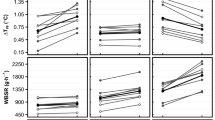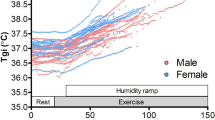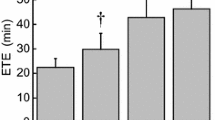Summary
An experiment was set up to quantify the relative influence of fitness, acclimatization, gender and anthropometric measures on physiological responses to heat stress. For this purpose, 12 male and 12 female subjects were exposed to a neutral [ambient temperature (T a) 21°C, relative humidity (r.h. 50%)], a warm, humid (T a 34°C, r.h. 80%) and a hot, dry (T a 45°C, r.h. 20%) climate at rest and at two exercise intensities [25%, and 45% maximal O2 intake (VO2max)], seated seminude in a net chair behind a cycle ergometer. Their physiological responses were recorded and the data submitted to a multiple regression analysis. It was shown that for the variance in heat storage, the percentage of body fat and the surface to mass ratio had relatively the largest influence of all the individual parameters, followed by VO2max and the sweat rate versus increase in core temperature (total r 2=92%). For the skin temperature variation, the relative influence of individual parameters (sweat gain, VO2max) was small. For body core temperatures, individual parameters had a large influence. The largest effect was due to the percentage of fat and the surface to mass ratio, followed by the sweating setpoint and, finally, VO2max (total r 2 = 54%−70%). For the variance in heart rate the VO2max was the most relevant parameter, followed by the setpoint of the sweat rate:rectal temperature relationship (total r 2=88%). Blood pressure and skin blood flow predictions were also shown to improve by the addition of individual characteristics to the model. Body surface area, VO2max and the sweating setpoint were shown to have a large influence but the proportion of the variance explained by these variables was too small (r 2 < 70%) to use them as strain predictors, however. For all the predicted variables, it was shown that gender lost its influence, once VO2max or anthropometric data were introduced into the prediction equation.
Similar content being viewed by others
References
Åstrand I (1960) Aerobic work capacity in men and women with special reference to age. Acta Physiol Scand 49 [Suppl 169]:1–92
Åstrand PO, Rodahl K (1986) Textbook of work physiology. McGraw-Hill, New York
Avellini BA, Kamon E (1980) Physiological responses of physically fit men and women to acclimatization to humid heat. J Appl Physiol 49:254–261
Burse AL (1979) Sex differences in human thermoregulatory response to heat and cold stress. Hum Factors 21:687–699
Buskirk E (1971) The physiological basis of rehabilitation. Saunders, Philadelphia
Davies CTM (1979) Thermoregulation during exercise in relation to sex and age. Eur J Appl Physiol 42:71–79
DuBois D, DuBois EF (1916) Clinical calorimetry: a formula to estimate the appropriate surface area if height and weight be known. Arch Intern Med 17:863–871
Durnin JVGA, Womersly J (1974) Body fat assessed from total body density and its estimation from skinfold thickness: measurements on 481 men and women aged from 16 to 72 years. Br J Nutr 32:77–97
Frye AJ, Kamon E (1981) Responses to dry heat of men and women with similar aerobic capacities. J Appl Physiol 50:65–70
Frye AJ, Kamon E, Webb M (1982) Responses of menstrual women, amennorrheal women and men to exercise in a hot, dry environment. Eur J Appl Physiol 48:279–288
Gagge AP (1973) Rational temperature indices of man's thermal environment and their use with a 2-node model of his temperature regulation. Fed Proc 32:1572–1582
Givoni B, Goldman RF (1973a) Predicting heart rate response to work, environment and clothing. J Appl Physiol 34:201–204
Givoni B, Goldman RF (1973b) Predicting effects of heat acclimatization on heart rate and rectal temperature. J Appl Physiol 35:875–879
Havenith G (1985) Individual parameters in thermoregulatory control; a review. Institute for Perception Report IZF 1985-26. Available from TNO, PO box 23, Soesterberg
Haymes E, McCormick R, Buskirk E (1975) Heat tolerance of exercising lean and obese prepubertal boys. J Appl Physiol 39:457–461
Houdas Y, Sauvage A (1971) La response du thermostat humain a une entrée pente de la charge thermique externe. J Physiol (Paris) 63:279–281
ISO (1982) Hot environments. Heat stress estimation for working humans, based on WBGT. International Standard Organization, Geneva, Report no. 7243
ISO (1984) Moderate thermal environments, determination of the PMV and PPD indices and specification of the conditions for thermal comfort. International Standard Organization, Geneva, Report no. 7730
ISO (1988) Hot environments-analytical determination of thermal stress (required sweat rate). International Standard Organization, Geneva, Report no. DIS 7933
Kenney LW (1985) Physiological correlates of heat intolerance. Sports Med 2:279–286
Mairiaux Ph, Malchaire J, Candas V (1987) Prediction of mean skin temperature in warm environments. Eur J Appl Physiol 56:686–692
Meyer JP (1981) Prevision de la temperature cutanee moyenne. Thesis, Université Louis Pasteur, Strasbourg
Missenard FA (1973) Temperature moyenne de la peau humaine en fonction de l'activité et de l'ambiance. CR Acad Sci Paris 277 D:1557–1559
Nadel ER, Pandolf KB, Roberts MF, Stolwijk JAJ (1974) Mechanisms of thermal acclimation to exercise and heat. J Appl Physiol 37:828–833
Nielsen B (1966) Regulation of body temperature and heat dissipation at different levels of energy- and heat production in man. Acta Physiol Scand 68:215–227
Roddie IC, Shepherd JT, Whelan RF (1956) Evidence from venous oxygen saturation measurements that the increase in forearm blood flow during body heating is confined to the skin. J Physiol (Lond) 134:144–450
Saltin B, Hermansen L (1966) Oesophageal, rectal and muscle temperature during exercise. J Appl Physiol 21:1757–1762
Saltin B, Gagge AP, Stolwijk JAJ (1972) Body temperature and sweating during exhaustive exercise. J Appl Physiol 32:635–643
Settels JJ, Wesseling KH (1985) Fin.A.Press: non-invasive finger arterial pressure waveform registration. In: Orlebeke JF, Mulder G, van Doornen UP (eds) Psychophysiology of cardiovascular control; models, methods and data. Plenum Press, New York, pp 267–283
Stolwijk JAJ (1971) A mathematical model of physiological temperature regulation in man. Report of NASA contractor CR 1855. Available from Pierce Foundation, New Haven, CT
Vogt JJ, Meyer-Schwertz MTh, Metz B, Foehr R (1973) Motor, thermal and sensory factors in heart rate variation. A methodology for indirect estimation of intermittent muscular work and environmental heat loads. Ergonomics 16:45–60
Wenzel HG, Mehnert C, Schwarzemau P (1989) Evaluation of tolerance limits for humans under heat stress and the problems involved. Scand J Work Environ Health [Suppl 1] 15:7–14
Whitney RJ (1953) The measurements of volume changes in human limbs. J Physiol (Lond) 121:1–27
Author information
Authors and Affiliations
Rights and permissions
About this article
Cite this article
Havenith, G., van Middendorp, H. The relative influence of physical fitness, acclimatization state, anthropometric measures and gender on individual reactions to heat stress. Europ. J. Appl. Physiol. 61, 419–427 (1990). https://doi.org/10.1007/BF00236062
Accepted:
Issue Date:
DOI: https://doi.org/10.1007/BF00236062




